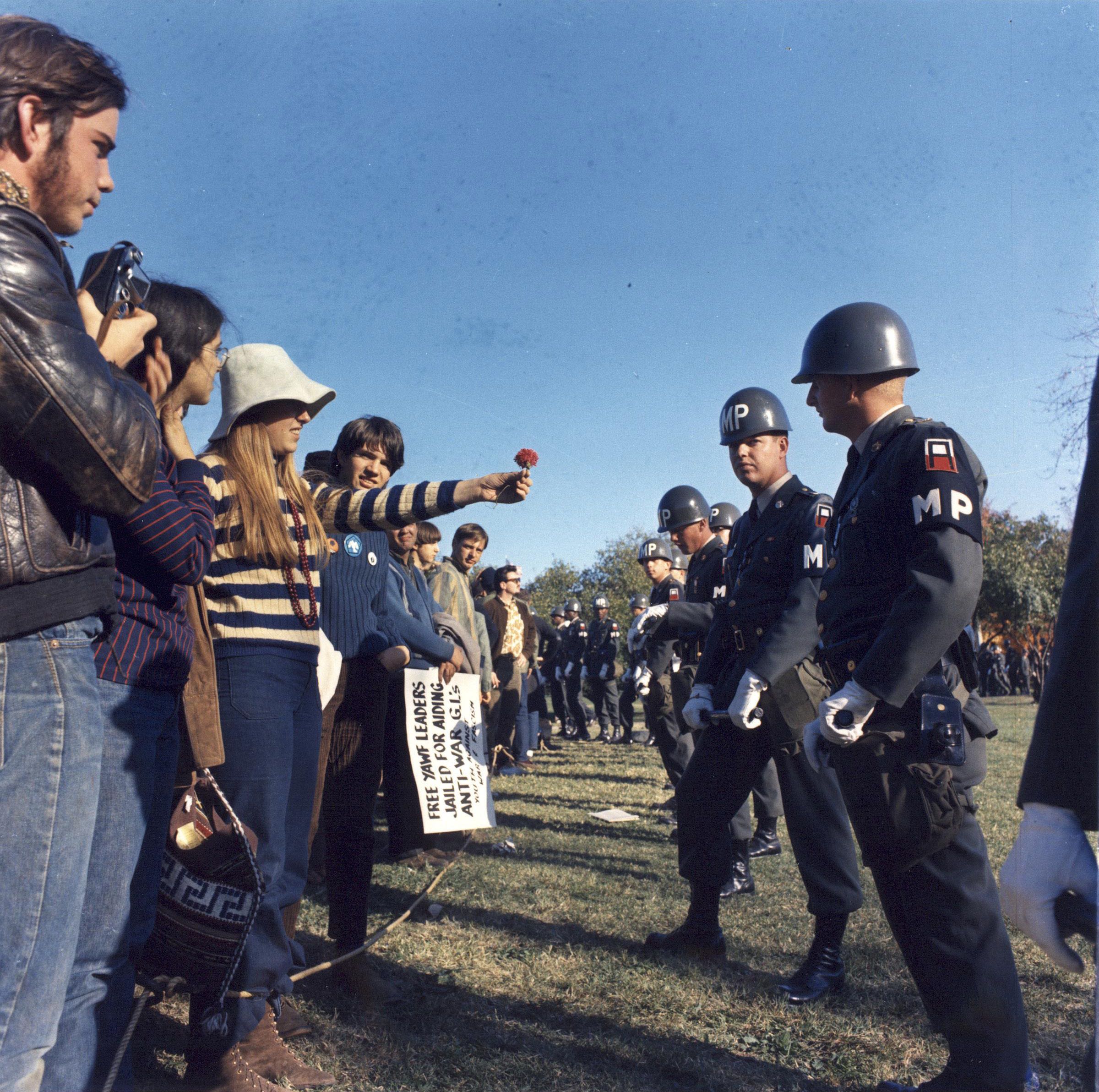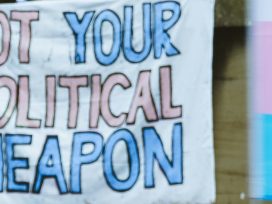Håkan Thörn (for Ord & Bild): For the past 50 years, Leftists all over the world have been living more or less in the shadow of 68. Still today, any discussion about the past, present and future of the Left (in a broad sense), sooner or later addresses the legacy of 68. Quite a few intellectuals have argued that the Left, perhaps with the exception of Latin America, has been in a constant state of crisis since 1968. Partly, it is argued, this is because any attempt at a broad mobilization has appeared futile in the light of the mass mobilization of the late 1960s, when, at certain moments, sections of the working class linked up with young middle class students in mass street protests in advanced capitalist countries. In this discussion, we will focus on the 68 movement in the United States and its contemporary legacy, but comparisons are perhaps inevitable. When compared to other advanced capitalist countries, what was specific about the US was of course the significance of how class and race were intertwined, and the role that the Black Power movement played. In addition, we did not see working class mobilization in the US to the same degree as was the case in, for example, France or Italy.
First, what does ‘68’ means to you today, politically and academically?
Margit Mayer: Academically, from a social movement research perspective, the 1960s are super-fascinating for two reasons:
One, for the overlapping and rapid succession and thus mutual synergizing of a variety of powerful movements – from the civil rights, then the anti-Vietnam War, the students’, and the free speech movements, then the environmental, the women’s (civil rights) movements, the turn towards Black Power and diverse so-called ‘minority’ movements – all with their own radical wings and with their own identity focus (the women’s movement establishing consciousness raising and differentiating between socialist, liberal, and radical feminists), the urban movements with both their community and riotous aspects, strands of some of these congealing in anti-poverty movements, and all paralleled by and intertwined with multi-faceted counter-cultural movements. Thus, a society-wide, internationally linked upheaval of repeated and cross-cutting cycles and waves – backlash and counter-movements included – which went on for more than a decade.
Two, all of these movements had significant reverberations – and not only nationally – in the media, in public debates, and in the political and legal systems. Their visibility (‘the whole world WAS watching!’) has been unparalleled. And their impacts on society have been multiple and lasting – in terms of loosening and freeing up lifestyles, gender relations, and also in terms of creating awareness of the interconnections between imperial lifestyles in the ‘first world’ and colonial and predatory oppression in the global South. Thus, while the New Left has certainly played an important role within this wave of movements, the 1960s represents something far bigger than the Left. At the same time it marks a potential of the Left – to connect the diverse movements of alienated and oppressed groups in one anti-capitalist struggle to overthrow the rule regime of wealthy, capitalist, sexist, racist, predatory and oppressive elites – which it could not deliver on at the time.
Politically, the 1960s represent a historical emancipatory movement, as it articulated a fundamental critique of Fordist capitalism and a promise of liberation from its injustices. For while this postwar model of capitalism entailed enormous economic growth and incorporated large sections of first-world working classes in that growth, it was predicated on the exclusion and oppression of ‘minorities’ and of women, on the exploitation and destruction of nature, and on the predation of colonies and ‘third world’ countries. It had sharp and vocal speakers to disperse this narrative, from prominent intellectuals such as Herbert Marcuse or Jean Paul Sartre, to protagonists such as Rudi Dutschke and Dany Cohn-Bendit in Europe and SDS leaders such as Tom Hayden or Todd Gitlin in the US.
The internal (strike waves, youth rebellions, and the various 1960s movements themselves) and external (oil shock, natural resources) limits of this Fordist model of growth became more apparent by the early 1970s, and political and economic elites have been busy ever since trying to establish new, sustainable growth cycles. As we now know: the ‘golden age’ of Fordism has been unique, yet in its crisis, to which the 1960s movements significantly contributed, the glaring injustices and oppressions of the capitalist mode of (re)production, which have become even sharper and more destructive under globalized austerity neoliberalism, were not only contested for the first time on a broad scale, but also shown to be man-made and therefore resolvable.
Don Mitchell: I was six years old in May 1968, But, even more-or-less safely cocooned in my white, upper, middle class suburb, I was certainly aware that the world around us was in turmoil. Martin Luther King had been assassinated the month before and Robert Kennedy would be assassinated the following month. Students were striking all around the Bay Area and the National Guard occupied the University of California, Berkeley, campus, where my dad was an engineering professor. Workers were also striking. Antiwar protests filled the streets. Within a few months, hundreds of students in Mexico City would be slaughtered (though I was far more interested in the Olympics that their slaughter made way for)…
All the while, the counter-revolt was brewing: on the rise were Richard Nixon (who later in 1968 would be elected president) and Ronald Reagan (who two years earlier – and one month after the founding of the Black Panthers – had been elected governor of California). And they were not alone. The racist Alabama governor George Wallace had a strong run at the presidency in 1968, and a majority of the population, if polls were to be believed, still were not opposed to the Vietnam War. ‘Law and order’ was just as much a call of the day as was the call to revolution, and while President Nixon was sometimes pressured into some pretty progressive positions (calling for a national minimum income, expanding funding for public housing), his administration was also laying the groundwork for the neoliberal revolution that would take off for real in the early 1970s (beginning with the US abandoning the gold standard in 1971).
Which is all to say, as Margit points out, that 1968 was a pivot point upon which the world turned – revolutionary in just that sense – and the world I came of age in was the world defined by it.
If these moments gave shape to the world I came of age in, then they gave shape to me. Personally, then, I have long been driven to understand the pivot point that was 1968, but especially its deep history (of militant labour movements, syndicalism, queer struggles, women’s fights) and its still-not-finished effects (in the shape of the landscape, in the nature protest and struggle, in the political economy). As researchers and political beings it is not at all that we are living through the wreckage of the sixties (as some, especially on the right, aver), but rather we live in the midst of the world that was made possible by the ways all kinds of radical (in all senses of that term) currents came together then. Every one of these currents came from somewhere – some precise set of wheres and whens in the long historical struggles over the geographies of our lives – and if we want to understand why and how they shape contemporary life, and contemporary political practice, then we need to figure that historical geography out.
Jordan T. Camp: The events of 1968 marked a turning point from which there was no turning back. This revolutionary moment marked a crisis of hegemony. While much has been written about the significance of events in Paris, Prague, and Mexico City, this crisis was expressed in US cities like Detroit and Memphis in the form of popular mobilizations against racism, war, and poverty. One of the more meaningful examples of these class struggles for me personally and politically was the Poor People’s Campaign launched by Martin Luther King and organizers in groups such as the National Welfare Rights Organization. The campaign demanded a shift in resources away from the US imperialist war in Vietnam and towards the abolition of poverty in the tradition of the ‘long civil rights movement.’ Sparked by the self-activity of the masses on the move from Watts (1965) to Detroit (1967), the campaign sought to organize a poor people’s march in the summer of 1968 beginning in Marks, Mississippi – the region with the highest concentration of poverty in the country – to Washington, DC, to demand a redistribution of wealth. In mobilizing a multiracial alliance of African Americans, Native Americans, Chicanos, Puerto Ricans, and poor whites, campaign organizers engaged in a terrain of class struggle that had been explored by an alliance of freedom and radical labour movements with roots in the radical 1930s.
It was in this specific historical and geographical context that the campaign took on its insurgent meaning. A veteran of peace, freedom and labour struggles, King had come to the conclusion that overcoming Jim Crow racial regimes would require a direct confrontation with capitalism and imperialism. He emphasized how the imperialist war strengthened the forces of reaction, and offered a critique that challenged the ‘common sense’ that had justified the anti-communist settlement underpinning the expansion of the ‘welfare-warfare state’ in the post-World War II period. At the same time, he articulated an alternative ‘good sense’ that offered a platform to organize a broad popular alliance against racism, militarism, and poverty.
King would not live to see the fruits of the Poor People’s Campaign. He was assassinated on April 4, 1968 in Memphis, Tennessee. His death led poor and working people to engage in burning and looting to protest in 130 cities. In response, the state deployed troops to crush the insurrections. The revanchist responses to the insurgencies demonstrated the power of the state’s security apparatus, but, as Margit Mayer suggests, they also sparked resistance and criticism by Black freedom, labour, socialist feminist, and student movements.
The fiftieth anniversary of 1968 represents an opportunity to reconsider how the revanchist response to the dramatic events gave rise to a new historical conjuncture. Like Don Mitchell, I want to emphasize that politicians from across the political spectrum promoted law and order resolutions of the crisis. As has been well documented, the prison population has exploded from 200,000 people in the late 1960s to 2.3 million people in the 2000s. In keeping with Ruth Wilson Gilmore’s analysis, this apparatus of state violence is part of a state-run system of permanent warfare.
Håkan Thörn: In a discussion on what kind of legacy ‘68’ has left us, it is perhaps important to say a few more words about the highly contested issue of what happened to the revolutionary movement of 68, which in the US at least, peaked in spring 1970 when 4 million students went on strike in response to the event at Kent State University, where soldiers shot and killed four students. After that, the movement seemed to die out, at least if we judge its strength by its ability to repeatedly take over the streets in cities across the US through recurring mass protests as well as riots. There seem to be at least three different narratives of what happened to the movement. The first one is the story of how the movement died because of internal friction and sectarianism. I suppose former SDS leader Todd Gitlin has been the most well-known proponent of this version of what happened (see The Sixties, 1987). Another narrative may be represented by Herbert Marcuse, who in the mid 1970s said, ‘the movement did not die, it was murdered’. He was, just like you Jordan and Don in this conversation, referring to the counter-revolt, the severe repression that hit the movement (the fact that demonstrators were gunned down by the National Guard in Berkeley and Kent State, that 29 members of the Black Panthers were killed by police in two years, the FBI’s counterintelligence program – COINTELPRO – with its sophisticated strategies to undermine both the New Left and the Black Panthers, etc.). This scenario would also include the bigger picture that you are referring to, Don, when you state that ‘the counter-revolt was already brewing’ – the neoliberal revolution (Milton Friedman published the extremely influential ‘The Role of Monetary Policy’ in American Economic Review in 1968 and he became Nixon’s advisor later the same year); or what you, Jordan, are calling the revanchist response, with the dramatically expanding state security apparatus. From this perspective, it could perhaps be argued that 68 was not so much a year of the New Left, but a year of sharpened conflict, and increasing mobilization on both sides, between the New Left and the emerging neoliberal-conservative forces, which eventually came out victorious. There is however a third narrative of what happened to the movement: it did not die, it transformed from being a movement of mass protest in the streets to a multitude of ‘new social movements’. This perspective indeed highlights how, as Margit put it, ‘the 1960s represents something far bigger than the Left’. Can I ask all three of you to expand a bit on ‘what happened to the movement’? To what extent are these narratives accurate? What are the important lessons to learn for contemporary movements here?
Don Mitchell: Obviously, all three explanations have merit. Indeed, sectarianism continued to metastasize into the 1970s, shaping and at times hobbling such potentially progressive and transformative movements as the Farmworkers Movement in California, where Cesar Chavez was so intent on rooting out leftists as he built his cult of personality that the UFW’s victories in the fields were more often Pyrrhic than lasting, as historians like Matt Garcia, journalists like Miriam Pawel, and worker-activists like Bruce Neuburger and Frank Bardecke have shown in an impressive bout of revisionist scholarship over the last few years.
Yet the sometimes self-inflicted wounds of sectarianism is hardly the whole story. Many radicals took themselves off to the shop floor (or out into the fields, as with Neuburger and Bardecke) to continue their organizing, seeking to spark radical and even revolutionary commitments among broad swathes of the working class. Yet others moved into the academy or various bureaucracies, together sparking institutional as well as cultural transformations – which over the long haul I think can be seen as revolutionary in the sense of turning the order on its head. The importance of this ‘long march through the institutions,’ as it has been dubbed, should not be underestimated, even if, as with any and all revolutions, the overturning has not been complete, and has been met every step of the way by counter-tendencies. There is some truth to the right’s complaint that universities have become leftist nests, and we should all feel pretty good about that, even as we know that our gains have been tenuous, subject to rapid erosion, sometimes outflanked, and all too often sold-out – as was the case, for example, with the rise of the horrid British system of neoliberal research ‘accountability’ – the Research Assessment Exercise and its successor, the Research Excellence Framework – which has destroyed intellectual independence and which now sets the global standard for assessing the ‘value’ of intellectual inquiry; it was invented, implemented and overseen by self-proclaimed leftists, after all.
And all three of these – sectarianism, the rise of new social movements that you noted, Håkan, and the march through the institutions – were significantly shaped by the repressive power of the state and capital as they launched their counterrevolution. And my sense is that – if we want to think about lessons for contemporary struggles – all three of these kinds of reactions, or something like them, are inevitable. Movements are struggles. This is to say that militants and activists caught in them are confronted, always, with problems: What’s the best way to go? How should we confront that power? What do we do about those in our midst seeking to co-opt us? How are we going to avoid, respond to, or slip away from the repressive use of violence? When we can’t move forward what way can we go? And when we win something, how do we hold on to it, institutionalize it, make it last? Knowing how those who confronted similar conundrums in the past helps us assess our own choices and moves in the present, not by continuing to fight the old battles but by thinking hard and critically – but also totally empathetically – about where (in hind sight) a wrong path was taken or a good and right one was forced open.
Jordan T. Camp: While the standard narrative of social movements in the late 1960s depicts the urban uprisings, antiwar and civil rights activism, prison rebellions, and Black power insurgencies as marking the collapse of ‘the movement,’ in my own work I have identified freedom struggles that were only emergent in the late 1960s and early 1970s. As such, I contribute a re-periodization of freedom struggles that takes the events of 1968 as a kind of turning point, rather than a denouement.
The premature resolution of the freedom struggles of the period has become a consistent feature of the dominant approaches to analyzing social movements. Forms of social protest taken up by the poor and the dispossessed against state violence and everyday and routine forms of surveillance and policing simply do not fit these models. This theoretical problem is due to a rigid distinction between activity considered legitimate political protest, and forms of self-organization and dissent deemed disorderly. The stakes in this debate are urgent, since the poor, people of colour, and working-class communities have organized themselves as insurgent communities of resistance throughout the period.
For example, between 1967 and 1973 workers in Detroit engaged in the most intensive cycle of strike activity since 1946. Race and class conflicts were being resolved by an urban working class led by organic intellectuals in organizations like the League of Revolutionary Black Workers and the Black Panther Party. At the same time, prison revolts ripped through the US culminating in the dramatic Attica rebellion in upstate New York in 1971. Many labour and freedom movement activists began to emphasize multiracial class struggles, turning to writings of antiracist and socialist intellectuals like W.E.B. Du Bois, Angela Y. Davis, Martin Luther King, and others to theorize and confront the articulation between racism, capitalism, and imperialism. Taken together, these struggles had a deeper imprint on the political culture than are often recognized.
The mass insurgencies in prisons, factories, streets, and fields alongside rising inflation, unemployment, and declining rates of profit led to a crisis of hegemony for capital and the state. In response, state officials deployed authoritarian solutions. While most histories of neoliberalism trace its origins to Chile in 1973, less attention has been paid to the relationship between the counterinsurgency against labour, freedom, feminist, and socialist struggles in North America and the neoliberal turn. To be sure, there were spectacular instances of racist state violence against the movement throughout the period such as in May 1970 National Guard Soldiers killed four students at Kent State University in Ohio, but we would be remiss not to note that same month police also killed two students and injured twelve more at the historically Black college Jackson State in Mississippi. These repeated repressive responses to events were in keeping with the state’s effort to crush the civil rights insurgency and growing resistance to the US war in Vietnam.
The story, however, does not end there. I believe that contemporary movements can draw significant lessons from the Marxist social theory that was produced in response to the crisis of legitimacy of the late 1960s and early 1970s. This tradition of radical thought offers key concepts and categories such as crisis, conjuncture, and contradiction needed to challenge the racist and revanchist law and order agenda that has legitimated the formation of the neoliberal state since its bloody inception.
Margit Mayer: Indeed, Don is right to point out that all three ‘narratives’ have merit, each points to an important piece of the elephant – the elephant being, as already became clear in the responses to the first question, a huge, heterogeneous, and immensely complex phenomenon that itself morphed through various cycles and stages in the course of almost 20 years. Gitlin addresses primarily the question of the role in and contribution of the (New) Left to the demise or dissolution of ‘the movement’; those who highlight the revanchist/repressive state and of ascending backlash and the counter-revolt as factor/s in the movement’s demise cast a wider net (or find a larger piece of the elephant under their microscopes). The third narrative is a response to an altogether different question: it is not inquiring into the causes of the demise of the movement. It simply observes a process (observable actually around the western world) of partial disintegration as some parts of the movements petered out while others changed form and/or focus, while many of the goals and demands that were so massively in the streets in the 1960s continued to be carried into institutions, factories, schools, churches, town halls, governments, etc. – and back into streets and squares and plazas, around the world and into globalizing networks, in efforts to continue the work of building less authoritarian, less racist, more just, more free, and more sustainable societies.
An aspect we have neglected in our conversation so far, but which is relevant when we want to bring the 1960s experience to bear on contemporary challenges, is the historical context that structures and shapes the transformative potential of any movement. This is important for assessing the success or failure of any social movement, but the more so for the 1960s movements, which provided so many impulses for modernizing, innovating and liberalizing post-war capitalist societies.
In all western countries, aspects of the emancipatory demands of the 1960s have been absorbed: sexual liberation, cultural pluralism, and democratizing efforts in many spheres have transformed social and political relations into freer, more liberal, more participatory, and more open directions. But it soon turned out that the neoliberal revolution – from industry 4.0 and the sharing economy to the welfare reforms – ‘mis-appropriated’ the revolutionary demands for autonomy, self-realization, freedom and creativity. While in the context of overbearing, intrusive, paternalist and bureaucratic (welfare) states the insistence on individual liberty and self-activation had a revolutionary edge, the ascendant neoliberal project gave these demands a different valence, as it incorporated them into competitive entrepreneurialism and the dismantling of social policies. Torn out of the context of collective/community solidarities (that challenged both bureaucratic and market rationalities), autonomy, self-management, and participation were harnessed as social technologies undergirding the gig economy and the precarization of not just the poor, but increasingly the 90%.
It’s certainly true that we/contemporary movements can always learn from those who ‘confronted similar conundrums in the past’ (as Don puts it), from tactics or action repertoires that proved more effective than others, from strategies that were useful for building alliances or in exploiting divisions amongst opponents. But most lessons travel uneasily from one historical context to another, simply because the scope of potential wins as well as the risks of getting hijacked or otherwise co-opted are always historically contingent – and thus the answers to each of the questions Don lists, and the application of the ‘traditions of radical thought’ produced in the 1960s and 1970s (that Jordan suggests) would look different in different historical situations.
While the confluence of various emancipatory movements and the resulting energy of the 60s was unique and posed a veritable threat context to the elites – which was met by often excessive repressive state reactions, which in turn politicized and radicalized, but eventually fragmented – and ‘murdered’ parts of – the movement, 50 years later we face a completely different situation. The neoliberalization of capitalism has thoroughly transformed the world, instead of ‘system competition’ we have TINA (‘There is no alternative!’), and everywhere right-wing populism is on the rise – often in direct response to neoliberal cut-backs and dispossession. Yet, the fact that more and more social groups get thrown under the bus has not only spawned right wing and xenophobic protest, but also many and growing progressive movements, and there are even trans-national alliances amongst them, such as Climate Justice and #MeToo.
Håkan Thörn: To what extent is the legacy of 68 still visible in the US today? Due to the distorted media representations of the political life in the US that we tend to get on this side of the Atlantic, I think many Europeans are unaware of the fact that there still exists a significant Left in the US. That is why many of us are quite surprised about the Gallup survey from 2016 showing that 55 percent of the US population between 18 and 29 think would like to see a socialist president. Whatever those figures mean, it at least tells us that perhaps fewer young people in the US are afraid of the word ‘socialism’ than in some countries in Europe where neoliberal hegemony is really strong these days. I think it is also not so well known in Europe that this North American Left is embedded in a broader field of social movement activism addressing social inequalities, racism, sexism and including anti-capitalist discourse. I suppose that the climate march in New York in 2014 was a manifestation of this. Not only was it the biggest environmental demonstration in history in any country (400,000 people), but it also manifested an alliance between the Environmental Justice movement that has largely been driven by poor black people, with more mainstream environmental movements and even labour unions. Similar kinds of alliances seemed to be involved in connection with the protest against Trump’s inauguration in early 2017 (the biggest demonstration in connection with an inauguration since Nixon’s election victory in 1968), where feminists sided with activists from Black Lives Matter and unions. Can you expand a bit on if, to what extent, and how, current mobilizations is a continuation of, and/or different from the protest wave of the 1960s? What are the challenges of contemporary movements?
Don Mitchell: Margit has fully laid out the challenges that movements on the Left face – in the United States and across the world. She is absolutely right that we live under changed historical conditions, and building solidarities and movements under these conditions is an enormous challenge. We all must take heart when they occur – for example in the Black Lives Matter and Climate Justice rapprochement that you mention. The work of building coalitions, strengthening movements, reaching across interests and issues, and – maybe especially – consolidating gains is enormously difficult.
Yet, I think the biggest challenge we face at the moment is ideological. As Margit says, before 1989 there was an alternative, as problematic as it was. Now, while it might indeed be the case that a large number of young people in the US (and beyond) favour ‘socialism,’ the content, and especially the analytical critique, of any socialist alternative remains murky. The return of a class analysis, heralded by the Occupy movement but also central to global anti-gentrification and anti-eviction movements, is salutary, but much more work needs to be done to better theorize class struggle in a way that fits not just the current moment – the kind of capitalism we are now in – but especially the realities of class itself. The differences between mobilizations then and mobilizations now, is that then militants had to hand reasonably coherent theoretical and ideological foundations for understanding what was up – from the old-line Marxism of Marx himself to the theories of alienation of Marcuse and Debord – that drove organizing and revolt (including feminist and other revolt against the understandings and practices of opposition themselves); now we have to recover and rebuild them under altered circumstances. We, more than they, need to get much better at specifying just what this thing called ‘socialism’ might possibly be. To me it feels less like 1968 right now than maybe early 1917.
Margit Mayer: As privatization, deregulation and precarization have restructured societies around the world, progressive movements everywhere confront new challenges as well as more opportunity structures than were prevalent in the 1960s. As a result, we have seen more connections and also similarities among progressive movements around the world.
For example, while the Civil Rights movement primarily framed the struggle of black people as one for equal rights – as did the following movements of other previously disenfranchised groups, this frame of ‘inclusion into the American Dream’ was first exploded with the formation of the Black Panther Party in 1966, and since 2014 the Movement for Black Lives, by now a coalition of more than 50 groups including Black Lives Matter, is again going beyond this framing. It builds on the tradition of direct action organizing as it has evolved since the 1960s, and most recently with Occupy, but it also goes beyond Occupy in that it has both (black) leaders and specific demands. As in the 1960s, the relationship between ‘the Left’ and the movements on the ground is tenuous. The tensions between ‘identity’ and ‘class’, which manifest in similar yet specific ways in Europe and the US, are far from resolved. The Left is divided over this issue, and the task of Marxist intellectuals in such a situation seems to me to provide sober assessments of the current predicaments, as neither starry-eyed ‘analysis’ nor exhortations (who should be in solidarity with whom) will help. It seems as if our conversation about this is only just beginning.
Jordan T. Camp: The fundamental ethical and political challenge of the current conjuncture is to confront the counterinsurgent tradition at the centre of the neoliberal project. The political task in this conjuncture is to build a popular political alliance for a social wage and against racism, militarism, patriarchy, and poverty. Indeed, activists, artists, and authors connected to social movements argue that this moment represents an opportunity to create a democratic advance. As such, the revolutionary democratic platform of the Poor People’s Campaign suggests a common basis for constructing a counterhegemonic alliance. They are reclaiming a collective memory of freedom struggles – shared perceptions about the history of movements that are sparking the imagination of political struggles in the present – and articulating possible futures. They provide an alternative archive of the memories, hopes, and social visions of the long civil rights era. The story of this insurgency and the wide circulation of its visions suggest that the making of the neoliberal state was not inevitable, and that alternative outcomes have been and continue to be possible.







